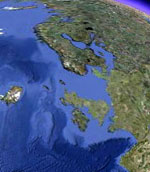BROWSE BY CATEGORY
- Archives and Libraries
- Blogs and Networking
- Bookmark This
- Digital Tools
- Examples of Teaching
- Exhibits
- Film Reviews
- History and Headlines
- Historic Sites and Museums
- Historical Thinking
- Holidays and Heritage
- Issues and Research
- Lesson Plans
- Material and Visual Culture
- Multimedia
- Organizations and Agencies
- Primary Sources
- Professional Development
- Publications
- Student Activities
- Teaching Materials
- Websites
Maps: They're Not Just for Geography Any More

Maps tell stories.
Not simply representations of objective spatial relationships, they are subjective texts, created by individuals and groups who decide the topic of a map, the purpose, the point of view, what is included, and what is left out. Imagine the difference between John Smith's view of Virginia that he mapped in 1612 and the perspective of today's NASA satellite images! Each map is evidence of a different historical narrative.
Integrating maps among the body of evidence from the past—not just as illustrations but as texts to be read as surely as are word documents—introduces different methodologies and approaches in the classroom. Thanks to the proliferation of digital technologies, maps become interactive resources; visual platforms that teachers and students can use to create, define, see and understand historic themes and concepts—as well as the places in which events unfold and how people thought about them.
It's one thing to access the extraordinary historic map collections now available online through private individuals, libraries, and archives. The David Rumsey Collection, the Perry-Castañeda Library Map Collection at the University of Texas, and the Newberry Library Map and Cartography Collections are among the largest collections. It's more difficult, perhaps, to make sense of maps, to integrate them into the curriculum, and to master the various technologies that make digital maps come alive.
At History Matters in Making Sense of Maps, author David Stevens writes that "...to fully understand a map we need to know how to decode its message and place it within its proper spatial, chronological, and cultural contexts." And he talks about how to do this.
Below you'll find a few other resources that may help.
The National Archives Teaching with Documents Lesson Plans offers a Map Analysis worksheet that helps map users define exactly what kind of map they're working with and what the map is intended to do or to show.
At the Newberry Library, Historic Maps in K-12 Classrooms consolidates a range of historic maps and lesson plans. Maps are thematically grouped in topics such as Exploration and Encounter and The Historical Geography of Transportation. Lesson plans specifically designed for K-2, 3-5, 6-8, and 9-12 accompany each map.
Stanford Spatial History Project takes an animated look at maps and timelines. The Shaping of the West includes multiple interactive maps and timelines showing how railroads grew and how they affected cattle and agriculture between 1867 and 1935. No lesson plans here, but the unique, animated visualizations may be useful to illustrate text-based narratives and to provide insight into changes over time.
Google Earth is invaluable as a teaching tool—but at first glance, the application is also intimidating if you're trying to figure out something beyond driving directions. Google Earth may take some time to learn, but basic tools are easier than they may appear, and the diversity of its usefulness in the history classroom is inexhaustible. Start with this wiki Google Earth (& Maps!) in the Classroom created by Joe Woods, a California educator, before moving to Google Earth for Educators. The wiki gives you an overview, provides basic directions for getting started, an introduction to Google tools such as Sketchup, and curriculum ideas.
Google Earth Lessons: An Educational Resource for Teachers offers video lessons, taking you step-by-step through Google Earth tools and uses. This British-based site also includes comprehensive classroom-tested lesson plans, K-12, for history-based google earth modules including goals, clear directions, skills the learning modules address, assessment tools, and additional notes.
Scribble Maps is another application that works on Google and makes learning just way too fun. It enables you to draw and write on Google maps. Students can map historic events, create timelines, annotate historic sites, and email their work or embed it in a blog or website. Fortunately, Scribble Maps is fairly self-explanatory, because instructions aren't readily found. The blog, however, includes a user-created short film demonstrating the tools and how to use them.
You'll find many more resources on the Clearinghouse via the search feature, from a Lesson Plan Review that critiques the effective use of maps in a content module to sources for templates of basic maps in outline.